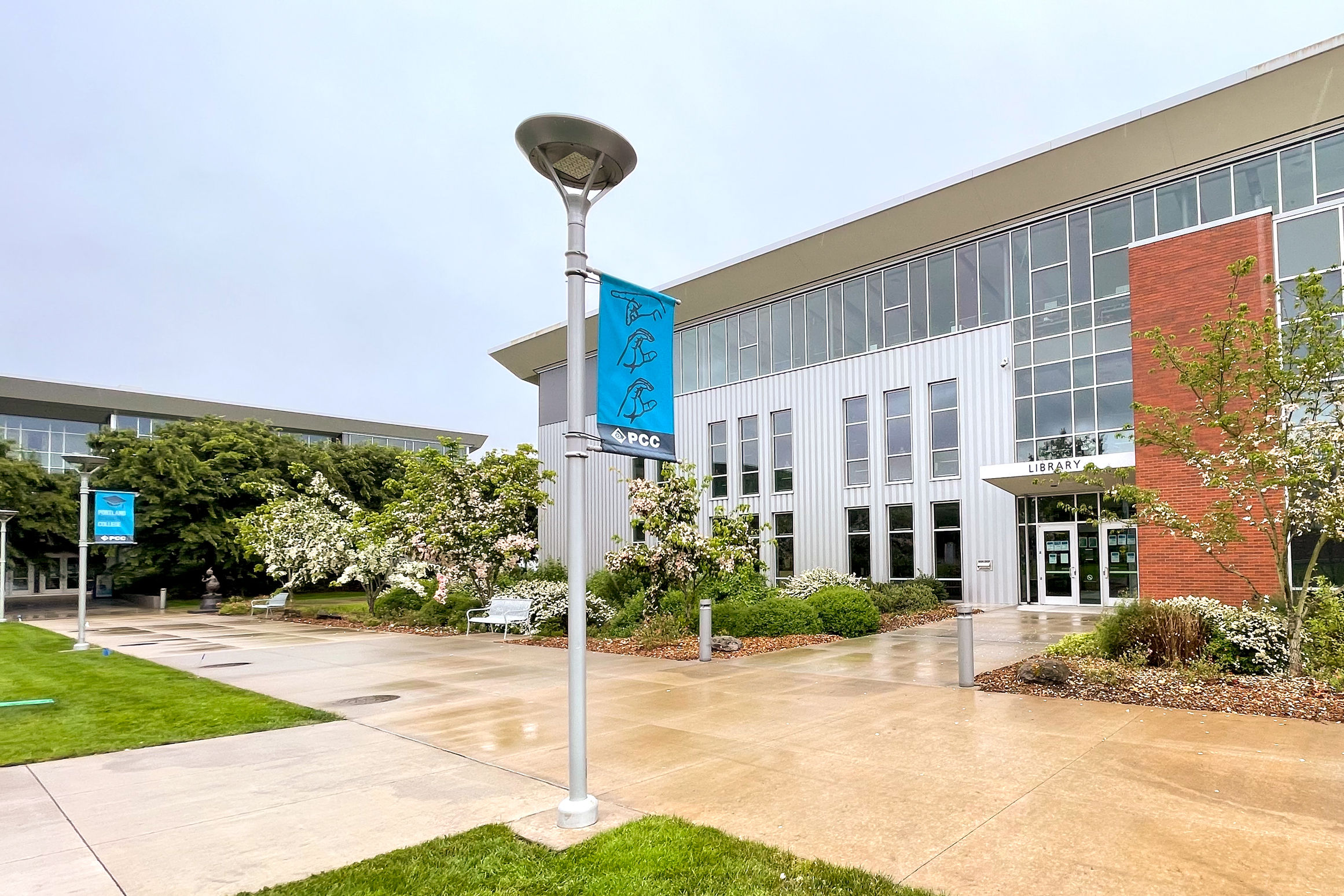
Students and Faculty at Portland's Biggest Community College Say They Want to Go Back to Campus This Fall
Above image: The library at Portland Community College's campus on SE 82nd Avenue, which has been closed to students and the public since the start of the pandemic. Photo by Brian Breneman
Portland Community College, the gateway to higher education for more than 60,000 students, is planning to keep its core academic classes almost entirely remote until next January, even as other academic institutions—including K-12 schools, universities and nearby community colleges—plan for much broader fall reopenings.
That stance, born from what top-level administrators call an abundance of caution and a laser focus on safety, has left some students and faculty members frustrated by what they say is a slow-roll that could wind up permanently depressing enrollment and thus, PCC’s footprint in the city, even as vaccinations push COVID-19 case levels down around the city and the state.
“We are missing a chance to connect with students” says Nicholas Hengen Fox, who teaches in the English department at PCC. “It’s hard to support the most vulnerable students if their internet isn’t working, or if they are depressed. Our work is to connect with students and really bring them along. We just can’t do that over Zoom in the same way.”
Because community colleges are primarily non-residential and serve students at all ages and stages in their post-secondary educational career, online learning has long been a constant in such settings. Pre-pandemic, at PCC, about 25 percent of classes were offered online-only, says Dean of Academic and Student Affairs Operations Kurt Simonds. When the pandemic hit, almost all other offerings joined those ranks.
Since then, select classes have been permitted to return to campus, mostly in hands-on areas, from auto repair to clinically-based health care courses; community resources like the student library and technology center, its childcare center and its food pantry have also been closed since March 2020, although all are tentatively scheduled to reopen in the fall.
The current fall plan expands the list of available offerings to include studio-based art classes and laboratory sciences, as well as dozens of hands-on career training courses, from dental assistant to landscape technology. After feedback that learning English solely online was tenuous at best, English for Speakers of Other Languages classes will be back in person too, as well classes geared toward students studying for their GED diplomas. But math, English, language, economics, social sciences, and other academic tracks will remain solely online.
Until recently, the school had opted not to widely broadcast this information to students, Simonds says, a nod to constantly-in-flux health guidelines and with registration for fall term pushed back to mid-July, though students are now being surveyed about their preferences. “A general message can’t provide any context about program specifics, and that is what students care about,” reads a section on the school’s FAQs about the limited fall return.
“Although the CDC and the governor have made statements about the opportunity to be more open, (the Higher Education Coordinating Commission, the Oregon Health Authority and the Oregon Occupational Safety and Health Administration) have not yet issued more guidance. We are prepared to move in the direction of being incrementally more open as the regulatory environment allows,” Simonds says. The school needs to comply with current regulations on distancing—which limit the number of students who can attend an in-person class, and the tuition revenue collected—as well as ensure updated ventilation in all classrooms, an ongoing and complex charge, Simonds says.
Trina Sound, a PCC student who started at the school last fall, says she’s spent her entire time there feeling “very disconnected. I haven’t had an on-campus experience.” At 31, Sound says she’s a non-traditional student, having returned to school after a six-year break. She’s scaled back her course load due to the pandemic, and says she hoped to at least have a choice to return to on-campus, in-person instruction in the fall, but all of the classes she’s planning to take are currently scheduled to remain in remote mode.
“Something needs to be communicated out in the month of June. All of us are pretty much waiting to see if we’ll be there [in-person] in the fall,” Sound says.
PCC student Heifara Wheeler says his workload has increased due to remote learning and was struggling to keep up—he says a hybrid curriculum, which would bring some classes back in person for those that wanted the option, would best meet student needs.
“I’m excited to experience what it means to be a student, meeting new people, participating in clubs, all the things that make you a student,” Wheeler says.
Public and private university systems around Oregon and the country are requiring that students show proof of vaccination against COVID-19 upon return in the fall. But that’s been far less common at community college, which are intended to be low-cost and low-barrier, and only a few have announced that they will follow suit. Simonds says PCC is studying such a requirement, but no decisions have been made.
Enrollment at PCC, as at community colleges nationwide, slid about 20 percent during the pandemic, as students had to cope with childcare issues of their own, or took jobs to support their families, before ticking up this spring, according to figures provided by the school, though it has yet to rebound to pre-pandemic levels. Enrollment of Hispanic/Latino students is up 19 percent over last spring, for example, and flat among Black students, but has declined by about 7 percent among Indigenous, Asian, and Native Hawaiian and Pacific Islander students.
Hengen Fox says he’s seen the enrollment fallout from online classes; even if students remain enrolled, he says, they sometimes vanish from his screen, and ghost him on email.
“My classes are full on day one, and then I lose more students that I normally do,” he says. “They just disappear. I am failing students who have turned in one thing and then they are gone.”
Reductions in enrollment fall hardest on adjunct or part-time faculty, says Frank Goulard, who teaches math at PCC and is the President of the PCC Federation of Faculty and Academic Professionals. Full-time faculty are contractually guaranteed a certain number of hours per quarter, and can “bump” part-timers in order to meet their quotes; adjuncts find out with minimal notice that they are either out of a job or working reduced hours as a result.
In a survey done in late March and early April, about 60 percent of faculty member said they were comfortable returning to teach in the fall, Goulard says. He’s guessing those numbers will rise with vaccination rates. The faculty union’s hope is that the school will extend some flexibility, he says, so that those who do want to teach in person have the ability to do so.
"If you don’t offer enough sections compared to neighboring community colleges, then it stands to reason that those students who do want to go to school (in person), they will go face to face at Mount Hood Community College, Clackamas Community College, Portland State—and PCC enrollment would decline,” Goulard says. "We will lose students, but the real tragedy is those students who only think of PCC. If they see PCC is not offering face-to-face classes, they might think, ‘I’ll give up on college.’”




